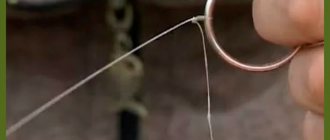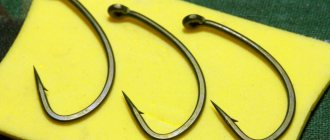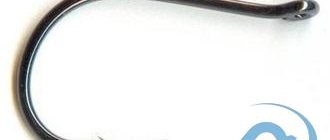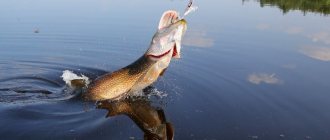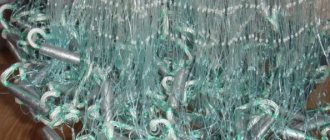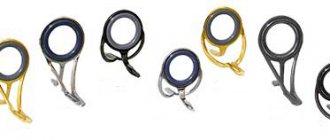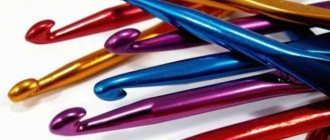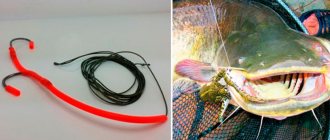Definition and purpose
Fishing hooks are used to hook caught fish and hold them when fishing. In baited gear, they also serve as the basis for attaching natural (animal or plant) or artificial (fly, rubber, foam) bait.
Let's see how a fishing hook can serve in different types of gear:
- Donks and floats involve the use of the simplest fishing hooks that are familiar to most. They are tied at the ends of leashes and equipped with baits for peaceful fish.
- Live bait gear is distinguished by the fact that, in addition to singles, they also use doubles and tees, which are equipped with fish.
- Numerous spinning baits are also equipped with tees: wobblers, spinners.
- In the installation of silicone rubber there is often an offset hook, which provides the equipment with non-snaking quality when placing the bait.
- In fly fishing, a fly is formed on the basis of a hook - an artificial decoy that imitates an insect.
In this fly the hook is almost invisible, although all installation is made on its basis.
On a note! Some baits can be equipped with several hooks, for example, wobblers. And in balancers they are presented in two types: soldered singles and suspended triples.
Types of fishing hooks
According to their appearance, fishing hooks are divided into two types:
— hooks with a straight or slightly curved shank;
- offset hooks.
Fishing hooks with a straight shank are:
- single. They have one eye, and in small hooks, instead of an eye, there may be a “head” under which the fishing line is tied;
Components
Every angler should know what parts the subject of our conversation today consists of. To help, we present a photo, below which we provide a description.
The main parts and parameters of a fishing hook.
Components:
- The head is the place where the hook is attached to the rest of the equipment. Most often it is made in the form of a round or oval ring. Less popular are spatulas.
- Forend – the straight part of the hook from the head to the hook. The length of the forend determines the type of bait used.
- The hook is the curve from the forearm to the sting. In turn, it is conventionally divided into the back of the head and the forehead: the back and front parts, respectively.
- The sting has two sides. On its inner side there is a barb that serves to hold the bait and counteract the fish’s attempts to free itself. The tip of the hook is crowned with the sting.
Attention! Nowadays, good manufacturers sharpen their hooks chemically, so their point is very sharp. And mechanical or pressed processing of the tip may also take place.
The presented photo also clearly shows the technical parameters of the hook:
- The diameter of the wire;
- width - the distance between the forearm and the sting;
- length - from the edge of the head to the top of the undercut.
Choosing a fishing hook
The first thing when choosing a fishing hook is to ask what material was used to make it. The most economical, simple and unreliable are hooks made from ordinary wire. If you decide that this type is suitable for you, then it is best to take such hooks in large quantities. However, be prepared for very frequent dressing changes, breakdowns and other headaches. But if your goal is to “learn how to tie hook knots well and quickly,” then this type is not bad at all, because the low cost of wire hooks is one of the main distinguishing features. However, remember that the hooks are in the middle price category in all respects and are three heads higher than their cheap counterparts.
The standard of quality and guarantor of reliability are hooks, the alloy of which includes vanadium and hydrocarbon steel. Yes, their price is quite high, but in addition to their excellent strength, such hooks are also very light and the thinnest.
In addition to the materials needed to make a hook, there is also a certain method of producing this fishing product - the “stamping” method, which directly increases the strength and reliability of the product by one quarter of the established standard. A distinctive feature of such a product is the flat shape of its base and the location of the sharp bend.
If a manufacturer resorts to high-temperature processing, then the resulting product will increase its strength by 30%.
There are also coatings of various metals that are applied to the hook itself during the manufacturing process. They are aimed at improving individual product characteristics, such as penetration, stainless steel, and different colors. Coatings made of special metals (gold, nickel, zinc and others) give the hooks special flexibility and a fairly long service life.
Classification and selection
To determine which hooks are best suited for your gear and not make a mistake in choosing, you need to have a good understanding of their classification.
By number of subdevs
Depending on the number of hooks, hooks are divided into the following categories:
- single;
- double;
- triple.
Doubles are produced in two versions depending on the size of the undercut:
- same size;
- of different sizes.
In the first case, the hook is made by bending one wire in equal proportions. It allows you to conveniently attach live bait through the mouth or mount a foam or silicone bait.
The second option is two hooks welded together: a large and a small one; such products are also called pike-perch hooks. Their main purpose is to plant fry for live bait fishing rods.
Separately, it is necessary to say about offset printers. These are products with one hook, but with a special forearm shape, designed for mounting silicone jig baits.
Different types of hooks have different purposes.
Special types
And we also need to mention the hooks, equipped with a wire spring designed to hold soft baits. With this addition, an ordinary single bowl turns into a mini-feeder, which is filled with dough, semolina and other similar attachments.
The second unusual hook can be called a non-hooking hook. In this case, a thin wire leading to the tip is soldered to the head. In a double and a tee, the number of such peculiar mustaches corresponds to the number of hooks.
By shape
Different fishing conditions dictate their own rules for the use of hooks of various shapes. The best of them are presented in the following photo.
Hooks also differ in the location of the sting relative to the center line. In some cases it is slightly bent from the vertical axis. And there are also models with beards on the fore-end. They are mainly used when it is necessary to bait a worm to prevent it from slipping.
By wire thickness
Everything is very simple here, the thickness depends on the resistance power of the intended trophy and the tenderness of the bait. For example, the thinnest ones are used in winter fishing to bait bloodworms; from a thick hook it will simply flow out.
Attention! More substantial hooks in terms of thickness are used for carp, carp, and catfish.
Hook shapes
Modern fishing is very rich in various types of bait and methods of delivering it right under the nose of the prey. But you don’t need to have absolutely every option for making hooks in your arsenal. It is enough to take a few of the most universal ones to be ready to catch both predators and peaceful fish. This is largely determined by the shape of the hook.
Single hooks
A single hook will be the only and correct choice for fishing for peaceful fish. Its modification with an extended fore-end is already well used in spinning fishing for predators.
Single straight hooks
Offset hooks
A single offset hook is used to catch predators using spinning tackle. This shape of the hook assumes that the sting is in line with the base of the hook in the body of the bait.
Offset hook
This makes it possible to mount the bait in such a way that it does not get caught on the algae when retrieving. The sting should be slightly recessed into the body of the bait so that it is easily released when bitten when the fish grabs the bait with its mouth.
Lure on an offset hook
Double hooks
Such hooks, as a rule, have an elongated shank and are designed for catching predators. This shape allows you to increase the likelihood and strength of the hook. This can be very important when catching such strong fish as catfish and pike or pike perch, which have many bony plates in their mouths that cannot be penetrated with one sting.
Double hook
Finnish hook for live bait
One of the varieties of double hooks is the so-called “Finnish hook”. This type of hook is used exclusively when catching large predators with live bait. The shape of the hook is very unusual and unlike other types. The Finnish hook is freely swallowed by the victim, after which it is very securely and deeply fixed in the throat or stomach. It can be extremely difficult to get it. Being caught on such a hook, the fish almost always dies from the wounds it receives while fishing. Because of this, this type of hook is considered extremely inhumane for sport fishing, although it provides maximum catchability.
Finnish hook with live bait
treble hooks
Hooks of this type are also used when catching predators, only with live bait or using wobblers and spinners. This is due to the fact that such baits can be attacked from any side: both from the tail and from the side, depending on the wiring and animation of the bait. It’s important to consider all the options here, and the treble hook does this perfectly.
Wobbler with treble hooks
Finish and color
How to use offset hook with weight
The next difference between the hooks is the outer coating. It is used for two purposes:
- protecting the product from corrosion;
- camouflage equipment under water.
Protect metal in the following ways:
- bronzing;
- nickel plating;
- tin servicing.
Coating colors are designated by the following English abbreviations:
- BK - black;
- BN - black nickel;
- BZ - bronze;
- GO - gold;
- NI - stainless steel;
- PS – red or pewter.
Red color is good for baiting a worm or bloodworm.
Fish hook color
The color of the hook depends on the material used to apply the protective layer and the paint coating applied over it.
To protect the hooks from corrosion, a bronze coating is most often applied, and then the hooks are given a color. They can be from dark to golden color.
As a result of nickel plating, fishing hooks receive an ideal surface. They can have colors with a variety of shades.
One of the most expensive ways to protect hooks is tin plating. Usually sea fishing is done with such hooks.
Dimensions
Most often, anglers discuss the size of fishing hooks. And it’s not surprising, because the overall success of fishing often depends on the number. It is usually recommended to make a compromise between sufficiency and miniaturization of size.
The sizes depend on two factors:
- the size of the mouth of the proposed trophy;
- volume of nozzle used.
Moreover, the second factor, as practice shows, is sometimes much more important. Agree, it is impossible to bait a bloodworm on a large hook, and a grasshopper on a small one.
Hooks are classified differently depending on the region. Our country has adopted the so-called domestic numbering; there are also international, Japanese, and Finnish ones.
Comparison table of hook numbering.
It is worth noting that Russian numbering is the most understandable. Our hook number corresponds to the width in millimeters. Look at the table, how can you find out what size No. 19 is in the international classification? And according to us, this is 2 millimeters - simple and clear.
Why this happened is explained by competition among manufacturers, who, by the way, often have identical numbers that do not match in size. And if we take our Chinese comrades, the picture will be even more beautiful; some try to adhere to the international numbering, others to the Japanese, and others to the Russian numbering.
Advice! When choosing a hook in a store, look less at its number and evaluate the product by its actual size.
Here is an approximate ratio of sizes and baits used, we present them according to the increasingly popular international classification:
- Nos. 28–24 – designed for the smallest baits: bloodworms, burdock moth larvae, small pellets of bread or dough.
- Nos. 12–16 – the optimal baits here are cereal grains, maggots, and medium-sized pellets of bread.
- Nos. 8–10 – sandwiches made from baits, large lumps of bread, a bunch of maggots, boilies, pellets.
- Nos. 6–7 – worms and their combination with maggots, snails, caterpillars, grasshoppers.
- Larger numbers are considered catfish or belong to offset baits on which silicone or foam rubber baits are mounted.
Classification
When choosing equipment, the fisherman is guided by two main factors - the expected size of the prey and the size of the bait. These factors directly influence the choice of the size of the RC.
Hooks are classified according to size. The hook is assigned a number depending on its size and entered into the classification table. But different countries are guided by their own numbering logic.
In addition to the international classification (English Reddit), there are national ones:
- Russian.
- Japanese.
- Finnish.
- Chinese.
Differences between different systems
Manufacturers
The undisputed leaders in the production of hooks are Japanese, American and Finnish companies. As for individual brands, the following stand out:
- Owner – the best hooks for catching carp fish;
- Mustad – tees for deep and winter predator fishing;
- Gamakatsu are leaders in the choice of sports anglers;
- Korum - products are distinguished by the most careful treatment of fish;
- Saikyo are the most affordable hooks in terms of price.
You shouldn’t discount Chinese manufacturers, whose products are becoming better every year, while remaining the most inexpensive in cost.
When choosing a hook from a well-known company, do not fall for a fake. The main differences between fake products can be seen in the comparative photo.
As can be seen from the list of leading brands, Japanese companies are the leaders in production. It is the hooks from the Land of the Rising Sun that are used by professional fishermen and athletes at the most important fishing competitions.
The best manufacturers
You need to choose a hook not only by size. All parameters of the Republic of Kazakhstan should be taken into account, but the main thing is quality. Quality can only be guaranteed by proven, best manufacturers.
Owner
The excellent quality of fishing hooks from the Japanese manufacturer is known all over the world. High price from 80 rub. for a simple single and from 300 rubles. for the tee is justified by high performance. Strength, sharpness, and grip are organically inherent in all hooks from this manufacturer.
Carp anglers can recommend the OWNER C-3 Carp Tsuyoshi 53263 No. 6 .
OWNER S-340 56912-14-0.10 are suitable for floaters .
For spinning players - tees OWNER 5611 BC-14 .
The only negative is frequent counterfeits from unscrupulous little-known manufacturers.
Mustad
Half of the hooks in the world are produced under this brand. Mustad fishing hooks are famous for their durability, despite the manufacturer’s desire to use thin wire in production. It is unlikely that the fisherman will be disappointed by such a policy, because the thinner the hook, the more catchy it is.
Recently, Mustad began producing firefly tees for deep fishing, for example, the Mustad tee with a glowing drop Grifon No. 14 .
Despite the high quality, the hooks from this company are not intimidating with their cost. For example, the above-mentioned tee is sold at a price of 25 rubles.
Gamakatsu
The well-known company is famous for the fact that, in addition to ordinary hooks, it produces hooks complete with reliable leashes. For example, a single hook with a leash Gamakatsu “BKS-1010B Maggots” No. 18/0 .
The price of 200 rubles does not seem overpriced; a reliable leash of excellent quality is not cheap in itself.
Tiemco
Well-known manufacturer of hooks for making fly fishing lures. His hooks are considered the standard of quality, so they are not cheap - from 280 rubles.
Following the catch-and-release principle of sport fishing, many hooks are made without a barb, for example: TIEMCO 60091 single TMC 206BL .
Almost all Tiemco hooks have a minimum barb size.
Practical recommendations for choosing
To choose the optimal hook and successfully catch exactly the fish for which it is intended, we will give several recommendations:
- choose products from manufacturers you know;
- try, if possible, to minimize the hook to the size of the bait;
- for fishing in sea water, use hooks protected from active substances;
- try to choose camouflage colors, for example, a red hook for bloodworms, a black hook for fishing on a dark muddy bottom, etc.;
- keep an eye on the sharpness of the hook, change it after particularly active fishing or sharpen it with a small file or sandpaper;
- store hooks in the bags in which they are sold in the store, and never in bulk in jars;
- on an equipped fishing rod, stick the tip into specially fixed pieces of foam rubber or similar soft material.
Hook tip
Some hooks have a tip that is bent inward. It turns out to be a kind of claw. With this form, the number of unsuccessful hooks is much less. It often happens that it is enough for a fish to swallow the hook up to half the sting and an instant hook follows, after which the hook is firmly embedded in the lip.
However, there is a minus in the hook bent inward. The fact is that fish with sluggish bites simply do not dare to continue eating. If the nozzle is attached to a straight sting, then there is a chance that the fish will still swallow it. The fisherman should have different types of such hooks available.
Features of choice for some conditions
For winter
Winter hooks are characterized by greater minimization compared to summer fishing. This applies to both the size and thickness of the wire from which they are made. In addition, it is recommended to equip winter gear with hooks whose shank length is one and a half times greater than its width. This is necessary to make it convenient in the cold to bait such a delicate creature as bloodworms, which is the number one bait in winter fishing.
For roaches in summer
Hooks for catching roach in summer are used no larger than number eight according to the international classification; larger sizes are considered carp. And even then, this value is only suitable for worm bait. For baiting with maggot, pearl barley or corn, it is optimal to equip fishing rods with hooks of 14–18 numbers.
Differences between hooks with a ring and a spatula
In simple terms, hooks with a spade are better suited for thin lines, and those with a ring are better suited for thick ones. If you tie the hook and ring correctly, the line will come out directly above the bend. Like this:
Spade hooks are suitable for lines with a diameter of up to 0.16 mm. In principle, leashes with a fishing line of this diameter are suitable for fishing for bream, crucian carp and roach. There are also hooks without a blade and an eye. There are notches on the top. These hooks are used with leader lines up to 0.12 mm. Such hooks hold the worm well and behave naturally.
